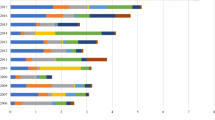Abstract
This article analyzes the influence of the strategy for diversification of natural gas suppliers, proclaimed by the European Union, on the economy of an importer country and studies the prospects of development for Russian natural gas exports. Studying the case of Lithuania as an example, which simultaneously imports Russian gas and transfers it to Kaliningrad Oblast, opportunities and prospects for implementing the policy of diversifying exporters have been considered. The directions of policy adjustment for Russian gas exports under varying conditions have been discussed.
Similar content being viewed by others
References
The Energy Charter Secretariat. The Price of Energy. International Pricing Mechanisms for Oil and Gas Prices. http://www.encharter.org/index.php?id=218&L=1. Cited May 2015.
S. I. Mel’nikova, What Is the Purpose of the Target Model? Innovations in the European Gas Market and the Interests of Russia. http://www.eriras.ru/files/mjelnikova_rgp_2-2012_kakova_cjel-rossija_v_globalnoj_ politikje.pdf. Cited May 2015.
A. D. Khaitun, “Russian energy policy in Europe,” Inst. Evr. Ross. Akad. Nauk, No. 226 (2008).
European Commission, Quarterly Report on European Gas Markets, Market Observatory for Energy DG Energy, Vol. 7 (2014). https://ec.europa.eu/energy/sites/ener/files/documents/quarterly_report_on_european_ gas_markets_2014_q4.pdf. Cited May 2015.
Klaipedos Nafta, LNG Terminal Project in Lithuania. http://www.lei.lt/energy-security-conference/index_-files/Masiulis.pdf. Cited May 2015.
GIIGNL Annual Industry Reports (2006–2012), International Group of Liquefied Natural Gas Importers. http://www.giignl.org/publications. Cited May 2015.
European Commission, Brussels, 7884 final, State aid SA.36740 (2013/NN), Lithuania Aid to Klaipedos Nafta—LNG Terminal (2013). http://ec.europa.eu/competition/state_aid/cases/250416/250416_1542635_ 190_2.pdf. Cited May 2015.
A. A. Shirov and A. A. Yantovskii, “Estimation of multiplicative effects in the economy. Opportunities and limitations,” Vseross. Ekon. Zh. EKO, No. 2 (2011).
Methodical Guidelines for the Calculation of the Macroeconomic Efficiency of Innovative Projects (Minist. Obraz. Nauki Ross. Fed., Moscow, 2006) [in Russian].
M. P. Timmer, E. Dietzenbacher, B. Los, R. Stehrer, and G. J de Vries, An Illustrated User Guide to the World Input-Output Database: The Case of Global Automotive Production. Review of International Economics (2015).
A. Damodaran, Investment Valuation: Tools and Techniques for Determining the Value of Any Asset (John Wiley & Sons, 2012).
Author information
Authors and Affiliations
Corresponding author
Additional information
Original Russian Text © D.V. Slesareva, 2017.
The given article was marked at the Contest of young scientist’' works dedicated to the 80-th Anniversary of Academician Yu.V. Yaremenko birth.
Rights and permissions
About this article
Cite this article
Slesareva, D.V. European policy of the diversification of natural gas supplies (in the case of Lithuania) and consequences for Russian gas exports. Stud. Russ. Econ. Dev. 28, 233–240 (2017). https://doi.org/10.1134/S1075700717020101
Received:
Published:
Issue Date:
DOI: https://doi.org/10.1134/S1075700717020101




